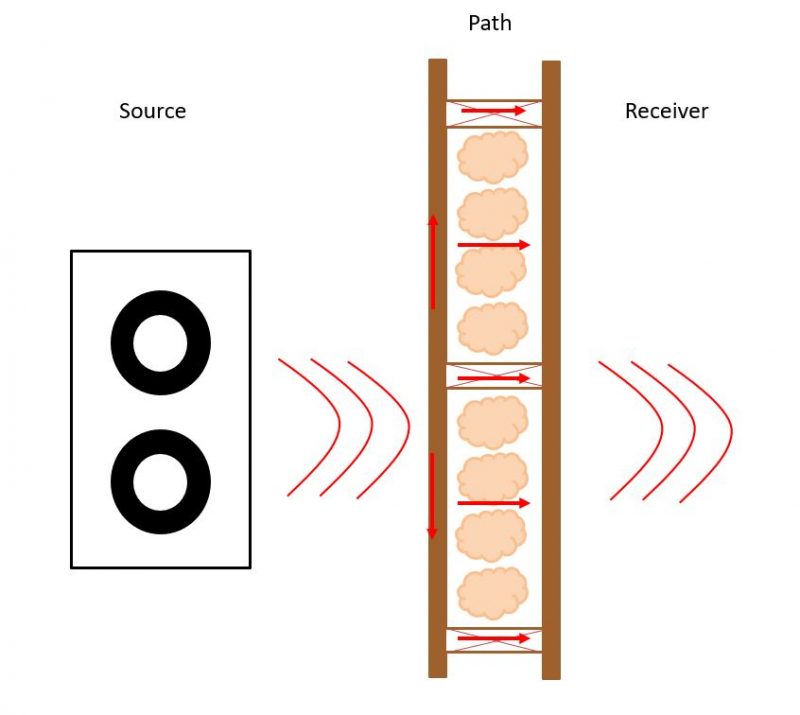No products in the cart.
Ultimate Guide to Soundproof Your Apartment

27
Dec
There are few places in the world you anticipate rest and peace like in your own home. But apartment renters across the country all too often experience the same issue – coming home to noise complaints and acoustic issues.
Sometimes it’s the noisy neighbor talking too loudly through the paper-thin walls. Just as often it is the traffic noise outside your window that makes it difficult to get a good night’s rest. Other noise sources include noisy appliances, noisy upstairs tenants, mechanical units, or TV and stereo units elsewhere in the complex.
While there is no one-size-fits-all solution to these issues, we can analyze them independently, and give our acoustic recommendation for each.
Navigation Menu:
- Acoustic Approach: Source-Path-Receiver
- Types of Noise
- Methods to Soundproof an Apartment
- Operational Soundproofing Approaches
- Architectural Soundproofing
- After-Market Soundproofing Options
- Apartment Soundproofing Summary
-
Guide to Soundproofing your Apartment
Acoustic Approach: Source-Path-Receiver
When analyzing and assessing a noise issue, Acoustic Consultants consider the source of the noise (people talking, traffic, mechanical equipment), the path the sound takes (through walls, over berms, underneath doorways), and finally, who is receiving the sound and how sensitive the receiver is (sleeping customer in hotel, patient undergoing treatment in a hospital, or a student trying to listen to a lecture in a classroom). By defining each of these elements, acoustic consultants may propose the most cost effective solution to a noise problem.
For instance, if an apartment renter is sleeping next to a window where traffic noise is consistent and disruptive. Very little can be done to reduce the source, such as moving the roadway or restricting vehicles at certain hours. Likewise, the receiver may consider moving apartments, or moving their bed to a different part of the apartment – neither of which are generally desirable. The pathway is a composite, or combination, of the exterior wall and the window. While the STC (Sound Transmission Class) of the exterior wall is likely 50+, most windows have an STC of 35 or less. Therefore, by treating the window as the path of least resistance, either by implementing a soundproof curtain or double-pane acoustic rated window, the path of the noise source is most easily treated.
When sound travels through a wall, it first comes from the Source (a speaker in this case). Then sound travels on its Path through the wall, where it goes through the drywall, through the cavity, through the studs, and comes out on the Receiver side.
-
Types of Noise
Not all noise is created equal. They obviously have different amplitudes (how loud they sound). But there is also a difference in “pitch”. High frequency noises (like a whistle or birds chirping) have much shorter wavelengths than deep pitches, like a rumbling truck or mechanical equipment. Low frequencies are much more difficult to block.
There is also a primary difference in the way that sound travels – either structure-borne or airborne. Airborne sound is traveling through the air particles, and can be easily reflected by adding a dense barrier. On the other hand, structure-borne noise (or “vibration”) is much more difficult to block, since adding more mass does not necessarily diminish the sound level, since the sound is traveling within and along the material. When structure-borne noise is persistent, it is often critical to treat the source of the noise rather than the path or receiver.
Methods to Soundproof an Apartment
There are 3 methods to soundproofing or mitigating noise issues. These are generally categorized into Operational, Architectural, and After-Market soundproofing methods. These approaches are not necessarily independent. Often-times an integrated approach, utilizing one or more of these options will produce the best results.
Operational Soundproofing Approaches
-
The Human Factor
There will always be times where it makes sense to have a civil conversation with others. That doesn’t mean banging on the wall or resorting to a shouting match. Neighbors respond best when they understand that their actions are affecting you, and that they may be preventable. Paying a quick visit, or even bringing over a small gift, may be great ways to help quiet the neighbors down.
There are also some new phone-based apps, such as AptApp, that act as anonymous ways to notify neighbors that they are being disruptive, while simultaneously notifying management. Property managers may then become aware of disruptive tenants that are bothering several neighbors.
-
Regulations and Noise Ordinances
You may also approach noise issues in a “legal” fashion, making formal noise complaints with the law enforcement agency in your jurisdiction. Many municipalities differ in how they define a “Noise Nuisance”. This is often in one of two ways:
- 55 dBA at the Property Line after 10 PM, or something of that sort. Quieter locations may have a lower dBA limit or an earlier start time. Conversely, lively neighborhoods sometimes do not start “Quiet Hours” until later in the evening, or at different times during the weekends. This noise ordinance must be measured with a calibrated Sound Meter and an experienced technician or engineer
- “Plainly Audible” legislation: many cities have found it easier to enforce if the noise is plainly audible to a uniformed officer after certain hours. While this ordinance is much easier to regulate, it is also much more subjective.
Regardless of the local definition, noise complaints may result in a fine, or even being brought in front of a Nuisance Review Board.
In regards to building codes, the primary code of revelance is International Building Code 1207.2, which states that all walls around a dwelling unit must have an STC of 50. Many apartments, maybe even most, fail to meet this soundproofing measure. An experienced Acoustic Consultant can come and perform a Field STC test for around $2000-$3000. If the code is not met, some apartment renters have had success in filing a Class Action Suit against the managers or builders, although a more likely outcome is to negotiate for lower rent.
Architectural Soundproofing
-
Soundproofing Apartment Walls – STC Improvement
A significant amount of noise complaints are generated by next-door neighbors that are immediately adjacent to your apartment. This is often due to “thin” walls that have low STC ratings, but may also be due to excessively loud neighbors, listening to music loudly or just staying up late or hosting parties.
Certain wall types are less likely to result in low STC ratings, such as CMU (Cinderblock) construction. Similarly, metal stud construction is much better than wood studs, and stud spacing at 24″ further improves the wall sound ratings. Other considerations are to use additional layers of drywall or sound membranes to achieve an STC 50 Wall.
Unfortunately, very little can be done to improve the sound rating of a wall after construction. There are number of acoustic “wallpapers” and paints that claim to achieve a high STC, but with very little field testing or lab data. Sometimes acoustic sealant can be used if there is flanking along the bottom of a wall, which can improve performance by a few dBs.
You may also consider re-arranging your living space so that you are further from the source. Getting bed frames off of the wall, even by only an inch or two. Furthermore, you may ask your neighbor not to mount TVs or frames on a shared wall, as this greatly increases sound transmission.
-
Soundproofing Apartment Floors – IIC Improvement
Floors are also notoriously difficult to improve after construction. They often under-perform rated IIC assemblies due to workmanship issues in the field, and the substitution of common hat channels rather than resilient channels for ceiling assemblies.
Tile and hardwood generally translate much more sound into the structure, and greatly benefit from an effective sound underlayment. Carpet with heavy padding on the other hand usually has very high IIC ratings.
Fortunately, adding a heavy shag carpet to a floor above your space may result in a delta-IIC of 10 points or more, reducing the sound you hear by 50%.
For walls and floors soundproofing options, treating the Source and Path are very difficult. Therefore, adding a Sound Masking machine to the “Receiver” is often the most economical approach, in addition to reaching out the primary noise creators. Sound Masking works by adding a background ambient noise to your bedroom or apartment space, making other noises less audible. There are many phone apps with sound masking options, as well as higher-end mechanical sound masking units.
After-Market Apartment Soundproofing Options
-
Apartment Window Soundproofing – Sealant and Soundproof Curtains
Much noise that disrupts modern apartment renters is generated outside of an apartment window, making it difficult for tenants to fall asleep and stay asleep. Window noise is particularly bad in apartment bedrooms, but may also be disruptive in living spaces.
Window STCs vary greatly, from 25 for single-pane windows to 35+ for double-pane acoustic windows. After the initial window installation, retrofits become prohibitively expensive. If windows are “drafty” even when closed, then using acoustic sealant on the window frame may be a cheap and effective way to soundproof the window.
An attractive option for many apartment renters to soundproof from traffic noise is to use soundproof curtains. These have a dense, heavy core that reflects sound. They have STC ratings of 21-25 points, effectively adding an additional window in front of an existing window! While not a good option if you have thin walls or existing double-pane windows, they can be a cost-effective solution if window noise is traveling through a thin window.
-
Door Noise Insulation – Sweeps and Sound Drapes
Noise intrusion from interior doors may also be disruptive, especially if you share an apartment with roommates. Apartment doors are often “hollow core”, meaning they are constructed from two thin pieces of laminate and the core is not filled with blown insulation or fiberglass. These doors do not need thermal insulation, and therefore, are also not treated to improve sound isolation. Hollow core doors may have performance in the STC 20-25 range, while solid-core doors may be 35+.
Furthermore, interior doors often do not have sufficient sweeps and seals around their edges. The “light test” is to turn off all the lights on one side of the door and leave them on from the other side. Then, at night, see if any light is visible on the dark side. If so, then there are significant sound leaks around the perimeter of the door. These may be prevented or limited by installing door sweeps and seals, which allow a flexible gasketing around the edge of the door.
Using a Door Sound Panel, such as the AcoustiDoor, adds significant mass to the door (similar to a solid-core door), but also seals around the edges similar to a Door Seal package.
Apartment Soundproofing Summary
As you’ve read, there are significant variations in sound types (structure vs airborne, low and high pitches), pathways (windows & doors, floors & walls), and receiver expectations. While some sounds are easier to block than others, it’s rare that a single solution magically fixes all issues. By combining soundproofing products with sound masking solutions, and addressing operational measures when possible, significant reduction in unwanted noise is possible.
-

